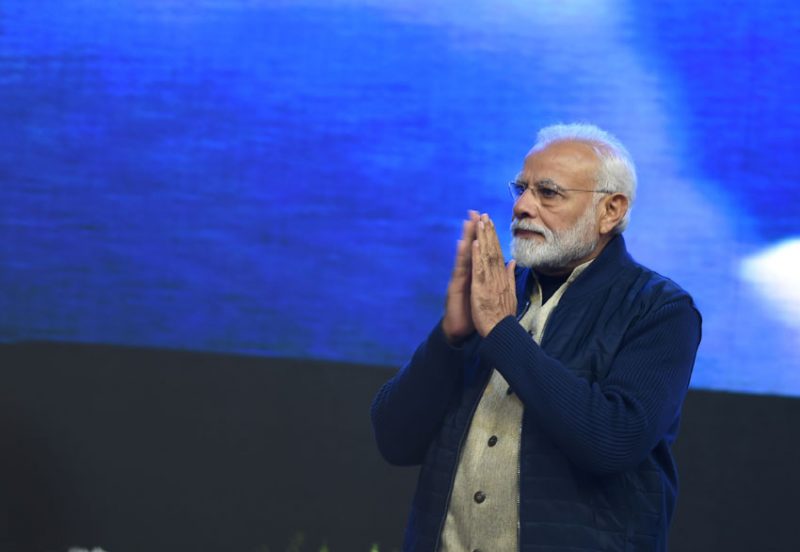Removing Corruption: Still a Work in Slow Progress
Indian Prime Minister Narinder Modi gestures during an inauguration event for several developmental projects in a major push for education and healthcare in the state, in Srinagar, Feb. 3. (Tauseef Mustafa/AFP/Getty Images)
Corruption has always been an issue in India, and the latest 2018 Corruption Perceptions Index (CPI) by Transparency International, based out of Brussels, amply demonstrates that along with most countries India too has not emerged out of this bane nor shown any major improvement, writes Priyanka Bhardwaj.
The measurement of the CPI Index involves surveys, based on “victims and witnesses”, in 180 countries and territories around the world, and employment of a scale of 0-100, with ‘0’ designated as highly corrupt and 100 attributed to the `very clean’ and aims at enabling governments and businesses to end the manifestations of corruption via the contravention of power, particularly in the context of public sector spending that aggravate incidences of bribery and opaque deals.
Topping this report are Denmark and New Zealand that have scored the highest while South Sudan, Syria and Somalia came at the bottom.
If none of the countries have managed the score of “0,” only 20 show significant progress since 2012, and 16, including China and the USA, have slid down from the top 20 positions, while Pakistan has ranked 117.
Apparently, India has improved in its ranking, to the 78th spot and a score of 41, a level shared with Burkina Faso, Ghana, Kuwait, Lesotho, Trinidad and Tobago and Turkey, presumably on the basis of the absence of big-ticket graft scams since Prime Minister Narendra Modi-led National Democratic Alliance government took charge at the center in May 2014.
Yet it holds less of a relief because none can fail to forget that Modi surged to power on the promises of setting into effect anti-corruption measures and strong fundamental reforms that comprised accountability of the police and bureaucracy that have not shifted their attitude of committing acts of severe transgression, negligence and ineptness and with impunity, their loyalties tuned to the latest dispensations of the day, rather than to the collective citizenry.
If there is one thing on which the NDA has not delivered it is its purposeful delay in forming a central anti-graft body, Lokpal, and state Lokayuktas, a public demand of 2011 India Against Corruption Movement that set the balls rolling for the passage of the Lokpal and Lokayuktas Act of 2013.
Certainly, there have been positives, from detecting financial disruptions in firms and anti-competitive behavior with regard to cartels, the Real Estate (Regulation and Development) Act, 2016, or RERA that ushered a degree of transparency in the housing sector to the benefit of home buyers, the bankruptcy law (Insolvency & Bankruptcy Code) that allows banks to pursue recovery without pressure or interference, and allegations of sexual harassments that were incorporated in appraisal reportage.
However, barring a few transactions most government ones still stay well within the veil of confidentiality and the prolonged delay in appointment of the Chief Information Commission that governs the implementation of the Right to Information Act too is symbolic of a genuine lack of political effort.
Classic cases of opacity were reflected in the processes of demonetization in 2016 as also amendments to the Prevention of Corruption Act that sought to ensure more teeth to punish bribery that however failed to negate its presence as a cost of doing business in the country, as also the incongruity in expecting transparency from those who are themselves compromised.
In the banking sector also, loan recovery stands at 13.7 percent, according to Trends and Progress of Banking in India 2017-18 Report by Reserve Bank of India, and only the top few cases of bankrupt firms are being scrutinized.
And in the upcoming general elections an expenditure of $8 billion is being estimated to be expended unofficially by political parties, as per Center for Media Studies.
There will be all the ills at display, from filing of false tax returns, to paid news, and distribution of cash, liquor and lavish gifts such as flat screen television sets, far above the individual leader’s spending cap of $100, 000 as allocated by the Election Commission.
At the pan India level as well government offices for property registration, police and municipal corporations function as hubs of perennial corruption.
The India Corruption Survey 2018 states that 91 percent of citizenry remains unaware of any anti-corruption helpline number of their states and approximately 82 percent of the respondents relayed the apathy of their state governments towards the corruption the people face.
Of all the states in the country, Uttar Pradesh in the north was voted to be the most corrupt, followed by Punjab and Madhya Pradesh.
Not even Delhi that is currently being governed by the Aam Admi Party, headed by Arvind Kejriwal who came into politics in 2015 solely on the promise of wiping out corruption, is believed to be free from corruption.
The stories in the subject do not end here, therefore the realm of anti-corruption in the country needs further revamping of laws when it comes to prosecution of corrupt practices among private bodies and payment of graft to public officials.
The message has to reach all that every perceived corruption case will be investigated and dealt with in a non-partisan manner to pave the path to a sincere democratic environment.


